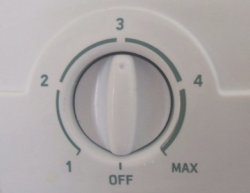Poor Fridge Usability Got Me Hot Under the Collar
Below is a photo of the temperature control of my new Hotpoint fridge. The dial is currently set in the middle of the range. Should I turn the dial left or right to make the fridge colder?

When I plugged in the fridge for the first time I set the dial to 1, which I thought was the lowest temperature setting. After a day or so I checked the fridge but it wasn’t much colder than room temperature. At first I thought it was an energy saving model that just wasn’t as cold as my previous fridge. However, after some experimentation, I discovered that I should have turned the dial to max to set the fridge to its coldest temperature. What went wrong?
Dials are familiar controls that produce a standard mental model: turning a dial to the right increases the value represented by the dial; turning the dial to the left decreases the value. For example, turning an oven dial to the right increases the temperature of the oven; turning the dial to the left decreases the temperature. Similarly, turning the dials of tumble driers and microwave ovens to the right increases the time these appliances remain on; turning the same dials to the left decreases the time. The temperature control of my fridge produces exactly the same mental model as these other kitchen appliances. And that’s the problem.
The temperature dial of my fridge is confusing because it is an indirect control. My experience with other kitchen appliances produced an expectation that turning the dial to the right would increase the temperature of the fridge, and that turning the dial to the left would decrease the temperature. At first glance, the scale on the dial suggests that setting 1 produces the lowest temperature and that setting max produces the highest temperature.
However, rather than setting the temperature directly, the dial controls the effort the fridge makes to cool itself; the greater the effort, the colder the fridge. In fact, setting 1 means the least cooling effort, which produces the warmest temperature, and setting max means the greatest cooling effort, which produces the coldest temperature. Therefore, to reduce the temperature of the fridge, I must set the dial to increase the cooling effort, which is an indirect and unnatural reverse mapping.
I’m not interested in how much effort the fridge makes to cool itself. I’m interested in setting the temperature and letting the fridge get on with it. Unfortunately, the scale of the dial suggests a direct natural mapping between dial and temperature: the labels 1, 2, 3 and 4 match exactly the temperatures in centigrade one would expect a fridge to maintain. The label max on the right of this increasing numerical scale reinforces a natural mapping.
I would redesign the dial to control temperature directly: turning the dial to the right would increase the temperature of the fridge; turning the dial to the left would decrease the temperature. The fridge would then decide for itself how much effort it requires to reach the temperature set with the dial. The dial would have a numerical scale that represents temperatures in degrees centigrade, with the lowest temperature, one degree centigrade, on the left and the highest temperature, five degrees centigrade, on the right:
1°C 2°C 3°C 4°C 5°C
This is an internationally recognizable scale that requires no localization.
